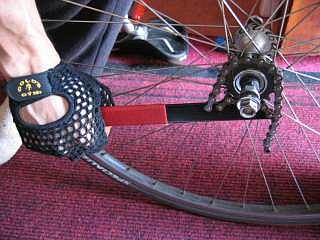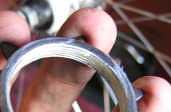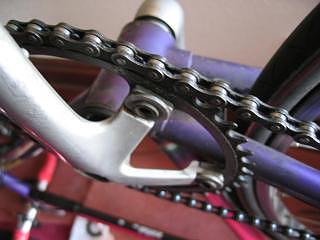 Riding "fixed" – no gears, no freewheel: the preserve of
leathery-skinned veterans and battle-hardened couriers, or a discipline
for the average cyclist?
Riding "fixed" – no gears, no freewheel: the preserve of
leathery-skinned veterans and battle-hardened couriers, or a discipline
for the average cyclist?
Forwards
I've been riding fixed gear pretty much exclusively since my curiosity
and insatiable tendency to fiddle created the context for
experimentation in 1991. Why would anyone then persist at it for another 12 years?
- Mass. You save a huge amount of weight,
the kind of weight that would give the titanium bolt brigade wet
dreams for weeks. Here's what you lose:
- Sprocket block – this is a monstrous lump of steel. Until you
hold its heft in your hand you cannot truly appreciate what you're
lugging around. Honestly, it is quite heavy.
- Chain – don't forget the chain ends up shorter;
30% perhaps. Again, all steel.
- Derailleurs, front & rear – more aluminium generally here
but still a decent pair of metal chunks.
- Shifters – you could remove these but it's probably
not worth it; you'd end up with ugly lumps sticking out of your down
tube whose threads would rust eventually. Keep them as a reminder of
what you're not missing. They lend the bike a certain "ooh! I can
play with these bits and not break anything!"-Exploratorium/Science
Museum feel.
- Chain ring – this barely weighs anything but has great
stripped-down visual impact when it's gone.
- Cables – again, not much but a bit more than I had imagined. A
definite aesthetic win too.
All that lot is quite a substantial percentage of the bike's mass.
- Technique:
- Fluidity. Obviously, with a fixed gear you don't
stop pedalling until the bike stops. (Yes, even over those
cattle-grids and potholes. More on that later...). So downhill
you start off gingerly pawing at the brakes but end up learning to move your
legs very smoothly indeed. And reduced upper body movement equates
to greater cycling efficiency.
- Full stroke. As you ride with higher and higher
(longer) gears you'll find that being able to pull up as you push
down goes from being useful to being absolutely essential, and
you'll get really good at it. I used to ride a 52/14x700c in Bristol
which is a notoriously hilly English city. At the time I first started
riding fixed there was no way I could've climbed the hills I was
tackling a year later.
- Strength. When you're forced to push hard your
muscles adapt. It's a natural by-product of riding fixed; you simply
can't help it. There's no "cheating" by twiddling in a lower gear.
See later though on starting gently and looking after your knees.
- Mental effort. This might sound odd, but not having
to think about either changing gears or whether to stop pedalling is
a remarkable load off the mind. You just crank, and keep doing that
'til you stop. With a freewheel, every time you coast there's a
whole-body effort as you fire up both the physical and mental
apparatus needed to regain speed. With a fixed gear instead there's
a whole lifestyle of continual movement.
- Maintenance. No derailleur to service, no flapping
chain to tear up the hub & spokes when it skips the top
sprocket, no cables to tension and tweak, and (what's left of) the
chainset gets less wear.
- Reliability. Not just the gears keep on working but
there's never a missed shift. Shimano produce some mind-bogglingly
beautiful equipment which will shift accurately under load but it's
still less efficient and less reliable than not shifting at all.
Consider that with practice i.e. building strength you could be
out-accelerating people in your single gear. What freewheelers might
gain in the first dozen or so meters they generally seem to lose as
they start messing with gears.
- Cost. If you've got a crappy groupset or one that's
coming to the end of its life, simply throw it away! Ka-ching.
- Retention. I just don't see a bike with no
freewheel or gears having the same resale value on the stolen market
as one with. I've had my current bike for I think fifteen years and
both before & after suffered multiple freewheel-equipped
losses.
Mind you, it could also be the bright pink and purple
color scheme...
- Posing. Both cyclists and non seem to put fixers in
a rarefied stratum somewhere between "hardcore" and "nutter". It
really isn't that big of a deal but for many of the freewheelers
it's way out of their box. A talking point at any rate.
- Trackstands. Perhaps this should be classified
under "posing" but it's a genuinely useful technique: by being able
to apply pressure in reverse you can rock the bike back and forth.
Usually a trackstand on a freewheel bike requires pointing uphill
somewhat as you can only push forward and must rely on the hill for
the backward movement, whereas on fixed you can do it on the flat
and even downhill.
- Fun!
Backwards
There are some downsides. If you live in a area with lots of
gradients it'll either be really challenging or a pain depending on
how you approach life in general. Use a lower gear and get good at
spinning on the downhills. You can always detach from the pedals...
 Changing gear on a fixed
is time-consuming and can require some serious exertion although
nothing a bike-shop couldn't help with. It's also advisable to center
the hub so the chain lines up: a rear wheel usually has spokes shorter
on the sprocket side.
Changing gear on a fixed
is time-consuming and can require some serious exertion although
nothing a bike-shop couldn't help with. It's also advisable to center
the hub so the chain lines up: a rear wheel usually has spokes shorter
on the sprocket side.
These are all quite minor in my opinion & experience. I survived
in Bristol. Changing gears is not a frequent activity –
start low and every few months as strength and skill improve try a
higher gear until it's comfortable. I have in all that time changed
gears probably less than ten times; each time requires probably
30mins tops.
I don't know if it's fixed gear or just because I treat my road bike
like an offroad vehicle, but occasionally the ol' steed might suffer a beating...
Starting grid
So, what does it take to get fixed up?
- Start calling every bike shop in your local area. It could take
a while to find anyone who sells fixed gears. I'd recommend starting
out with a 17- or 18-tooth sprocket, running against the usual
42-tooth front (inner) chainring. If you're fixing up a mountain
bike (good for you!) adjust to taste. Perhaps try a 14-tooth against
the 32-tooth middle ring. Make sure you get a 3/32" sprocket not a
1/8"; it's unlikely you'll ever see a 1/8" but I've had a narrow
miss with one once.
- Remove all the bits. There's a lot of them and it'll take a while. You'll enjoy every
minute of it, I promise.
- Put the whole lot in a bag, and marvel at what you'll be leaving behind, each and every
time you go for a ride.
- Do 3. again. You won't be able to help it.
 Thoroughly clean and grease both the hub and sprocket's thread, including where
the sprocket meets with the hub. At some point you'll want to unscrew it and god help you if
the steel, water, and air's found a bare section to bind with the aluminium.
Thoroughly clean and grease both the hub and sprocket's thread, including where
the sprocket meets with the hub. At some point you'll want to unscrew it and god help you if
the steel, water, and air's found a bare section to bind with the aluminium.
- [Interlude] It's quite possible some well-meaning but
ignorant bike mechanic or shop assistant will insist or remind you
that you need a locking ring or special type of cross-threaded hub
to ensure the gear doesn't unscrew. In practice, this is entirely
unnecessary. Once you've jammed on the gas for a few cranks that
little sucker will be on so tight you'll need good tools and some
thick leather gloves to get it off again. Find out how to change a fixed
gear and see for yourself!
PS Thanks to David Frech
who pointed out this neat technique for
tightening a sprocket, if you want to perform this tightening before
setting off and cranking yourself.
- Now the adjustment bits: it's probably necessary to,
- take the opportunity to fit a strong non-quick release axle. Hint: ask for a
tandem version; it'll weight more but you can really abuse it,
 realign the hub by adjusting the spokes to equal length; you shouldn't need to get new
spokes,
realign the hub by adjusting the spokes to equal length; you shouldn't need to get new
spokes,- remove the hub nut spacer on the cluster side,
- using some traditional wheel nuts facing out,
- copious fiddling with combination of nuts to get the right spacing for your frame,
- (or just squeeze the rear triangle ;-)

either: remove all but one of the front chainrings and use spacers in their place, or keep it and do nothing.
You may well find enlisting your local bike shop to help a good idea. Be prepared for
strange looks and the almost-guaranteed locking ring conversation.
First cranks
 The beginning rides are a little odd, and the ferocity of the fixed
chaindrive will make itself apparent the first few times you forget.
It's not hard to pick up the keep-crankin' discipline but watch out for
when you have to concentrate on something else: an unexpected traffic
situation, a hole in the road, a good looking... It's easy to be
prepared though. Here are some things to practise:
The beginning rides are a little odd, and the ferocity of the fixed
chaindrive will make itself apparent the first few times you forget.
It's not hard to pick up the keep-crankin' discipline but watch out for
when you have to concentrate on something else: an unexpected traffic
situation, a hole in the road, a good looking... It's easy to be
prepared though. Here are some things to practise:
- Brake hard whilst pedalling. Essential skill.
- Bunny-hop holes, and up and down kerbs. There's definitely
a knack to this and you'll learn to hop from any pedal position and
even continuing to spin while airbourne. Mentally prepare for that
time you have to deal with something in the road; the last thing you
need is a battle with a forceful pedal rearing up on you.
- Either figure out how to push off from any pedal position, or apply
the front brake lifting the rear wheel a little and cranking the
machinery to your preferred position. I used to do the former and
now do the latter as getting away across the lights before other
vehicles in London traffic is a big win.
- Ride with clipless pedals. There's a preconception that being
strapped into the machine is somehow dangerous, particularly so
without a freewheel. Quite why people think it's any different with
a direct drive I don't quite understand. Certainly, anyone who's
ridden with clipless pedals (in either configuration) for more than
a couple of hours knows these concerns are totally unfounded. Once
you figure out how to disengage it quickly becomes a natural,
sub-second movement.
- Push it. Make progress. Get stronger. Use higher gears as you find
yourself maintaining a cadence that's at the upper end of what's
comfortable for you. I do recommend starting out with a gear that
almost seems too low, and generally sticking to a gear where
cruising is at a relatively higher crank rate. There'll be plenty of
time to stamp on it accelerating and climbing: you'll be glad you're
not in Overdrive then.
Into the sunset
That's it! Happy fixing! Any comments or questions I'd love to hear
from you.
 Riding "fixed" – no gears, no freewheel: the preserve of
leathery-skinned veterans and battle-hardened couriers, or a discipline
for the average cyclist?
Riding "fixed" – no gears, no freewheel: the preserve of
leathery-skinned veterans and battle-hardened couriers, or a discipline
for the average cyclist?
 Changing gear on a fixed
is time-consuming and can require some serious exertion although
nothing a bike-shop couldn't help with. It's also advisable to center
the hub so the chain lines up: a rear wheel usually has spokes shorter
on the sprocket side.
Changing gear on a fixed
is time-consuming and can require some serious exertion although
nothing a bike-shop couldn't help with. It's also advisable to center
the hub so the chain lines up: a rear wheel usually has spokes shorter
on the sprocket side.
 Thoroughly clean and grease both the hub and sprocket's thread, including where
the sprocket meets with the hub. At some point you'll want to unscrew it and god help you if
the steel, water, and air's found a bare section to bind with the aluminium.
Thoroughly clean and grease both the hub and sprocket's thread, including where
the sprocket meets with the hub. At some point you'll want to unscrew it and god help you if
the steel, water, and air's found a bare section to bind with the aluminium.
 realign the hub by adjusting the spokes to equal length; you shouldn't need to get new
spokes,
realign the hub by adjusting the spokes to equal length; you shouldn't need to get new
spokes,
 The beginning rides are a little odd, and the ferocity of the fixed
chaindrive will make itself apparent the first few times you forget.
It's not hard to pick up the keep-crankin' discipline but watch out for
when you have to concentrate on something else: an unexpected traffic
situation, a hole in the road, a good looking... It's easy to be
prepared though. Here are some things to practise:
The beginning rides are a little odd, and the ferocity of the fixed
chaindrive will make itself apparent the first few times you forget.
It's not hard to pick up the keep-crankin' discipline but watch out for
when you have to concentrate on something else: an unexpected traffic
situation, a hole in the road, a good looking... It's easy to be
prepared though. Here are some things to practise: